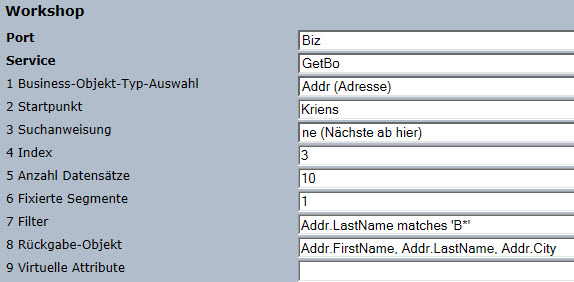WebService-Operationen
Die kleinsten Funktionsblöcke welche bei WebServices aufgerufen werden können, werden als "Operationen" bezeichnet. Hier werden diese Funktionsblöcke beschrieben.
- Es steht nicht pro OpaccERP-Service eine entsprechende typisierte WebService-Operation zur Verfügung (Design-Entscheidung).
- Die "technische Dokumentation" kann der WSDL-Beschreibung entnommen werden.
EncryptPassword
Mittels dieser Operation kann
das Benutzer-Passwort, welches bei den anderen Requests
mitgegeben werden muss, verschlüsselt
werden.
Beispiel-Request:
... SOAPAction=http://www.opacc.com/Opacc/ServiceBus/Interface/Ws/Generic/Generic/EncryptPassword ... <SOAP-ENV:Envelope xmlns:SOAP-ENV="http://schemas.xmlsoap.org/soap/envelope/" xmlns:SOAP-ENC="http://schemas.xmlsoap.org/soap/encoding/" xmlns:xsi="http://www.w3.org/2001/XMLSchema-instance" xmlns:xsd="http://www.w3.org/2001/XMLSchema"> <SOAP-ENV:Body> <m:EncryptPassword xmlns:m="http://www.opacc.com/Opacc/ServiceBus/Interface/Ws/Generic"> <m:plainPassword>TOP-SECRET</m:plainPassword> </m:EncryptPassword> </SOAP-ENV:Body> </SOAP-ENV:Envelope>
Beispiel-Response:
<s:Envelope xmlns:s="http://schemas.xmlsoap.org/soap/evelope/"> <s:Body> <EncryptPasswordResponse xmlns="http://www.opacc.com/Opacc/ServiceBus/Interface/Ws/Generic"> <EncryptPasswordResult>024VsUIfGzvzUpE0GIvbZK6OQ==iG5MMWkcNsx/Pt6W3sYSlA==</EncryptPasswordResult> </EncryptPasswordResponse> </s:Body> </s:Envelope>
WichtigDas so verschlüsselte
Passwort kann nur für die Kommunikation über die WebService-Schnittstelle
verwendet werden!
|
FlatRequest
Mit dieser Operation können die
OpaccERP-Services aufgerufen werden. Dies analog zur Sicht, wie sie die
OpaccOXAS LiveDocumentation bietet.
NotizIm Normalfall müssen im
Kontext nur Mandant, Benutzer und Passwort mitgegeben werden. Für "PortId"
wird im Normalfall "Biz"
verwendet.
|
Beispiel-Request...
...
SOAPAction=http://www.opacc.com/Opacc/ServiceBus/Interface/Ws/Generic/Generic/FlatRequest
...
<SOAP-ENV:Envelope xmlns:SOAP-ENV="http://schemas.xmlsoap.org/soap/envelope/"
xmlns:SOAP-ENC="http://schemas.xmlsoap.org/soap/encoding/"
xmlns:xsi="http://www.w3.org/2001/XMLSchema-instance"
xmlns:xsd="http://www.w3.org/2001/XMLSchema"
xmlns:m0="http://www.opacc.com/Opacc/ServiceBus/Interface/Ws"
xmlns:m1="http://schemas.microsoft.com/2003/10/Serialization/Arrays">
<SOAP-ENV:Body>
<m:FlatRequest xmlns:m="http://www.opacc.com/Opacc/ServiceBus/Interface/Ws/Generic">
<m:PortId>Biz</m:PortId>
<m:OperationId>GetBo</m:OperationId>
<m:RequestContext>
<m0:ClientId>1</m0:ClientId>
<m0:UserId>73</m0:UserId>
<m0:Password>024zdDTexfRPU3YBkEp0DS8SQ==FG1CiEqHoXFehLnfrifnjw==</m0:Password>
</m:RequestContext>
<m:RequestData>
<m:Parameters>
<m1:string>Addr</m1:string> <!-- BO-Type -->
<m1:string>Kriens</m1:string> <!-- Startpunkt -->
<m1:string>ne</m1:string> <!-- Suchanweisung -->
<m1:string>3</m1:string> <!-- Index -->
<m1:string>10</m1:string> <!-- Anzahl Datensätze -->
<m1:string>1</m1:string> <!-- Fixierte Segmente -->
<m1:string>Addr.LastName matches 'B*'</m1:string> <!-- Filter -->
<m1:string>Addr.FirstName, Addr.LastName, Addr.City</m1:string> <!-- Rückgabe-Objekt -->
<m1:string></m1:string> <!-- Virtuelle Attribute -->
</m:Parameters>
</m:RequestData>
</m:FlatRequest>
</SOAP-ENV:Body>
</SOAP-ENV:Envelope>
...für folgende
Eingaben:

Beispiel-Response:
<s:Envelope xmlns:s="http://schemas.xmlsoap.org/soap/envelope/">
<s:Body>
<FlatRequestResponse xmlns="http://www.opacc.com/Opacc/ServiceBus/Interface/Ws/Generic">
<ResponseInfo xmlns:a="http://www.opacc.com/Opacc/ServiceBus/Interface/Ws"
xmlns:i="http://www.w3.org/2001/XMLSchema-instance">
<a:Successful>true</a:Successful>
<a:MessageId>NoBoth</a:MessageId>
<a:MlsMessageText/>
</ResponseInfo>
<ResponseData xmlns:i="http://www.w3.org/2001/XMLSchema-instance">
<RowCount>9</RowCount>
<ColumnCount>3</ColumnCount>
<Columns>
<Column>
<Name>Addr.FirstName</Name>
<Rows xmlns:a="http://schemas.microsoft.com/2003/10/Serialization/Arrays">
<a:string/>
<a:string>Hans</a:string>
<a:string/>
<a:string>Meinrad</a:string>
<a:string/>
<a:string>Michelle</a:string>
<a:string>Monika</a:string>
<a:string>Hans</a:string>
<a:string/>
</Rows>
</Column>
<Column>
<Name>Addr.LastName</Name>
<Rows xmlns:a="http://schemas.microsoft.com/2003/10/Serialization/Arrays">
<a:string>Battagello + Hugentobler</a:string>
<a:string>Baumann</a:string>
<a:string>Bieri Federn + Bremsen AG</a:string>
<a:string>Bless</a:string>
<a:string>BOVE</a:string>
<a:string>Brändli</a:string>
<a:string>Brügger</a:string>
<a:string>Bucher</a:string>
<a:string>Bur & Co. "Burekönig"</a:string>
</Rows>
</Column>
<Column>
<Name>Addr.City</Name>
<Rows xmlns:a="http://schemas.microsoft.com/2003/10/Serialization/Arrays">
<a:string>Kriens</a:string>
<a:string>Kriens</a:string>
<a:string>Kriens</a:string>
<a:string>Kriens</a:string>
<a:string>Kriens</a:string>
<a:string>Kriens</a:string>
<a:string>Kriens</a:string>
<a:string>Kriens</a:string>
<a:string>Kriens</a:string>
</Rows>
</Column>
</Columns>
</ResponseData>
</FlatRequestResponse>
</s:Body>
</s:Envelope>
GenericRequest
WichtigDiese
Operation steht nur für interne Zwecke zur Verfügung und wird an dieser
Stelle nicht näher beschrieben.
|